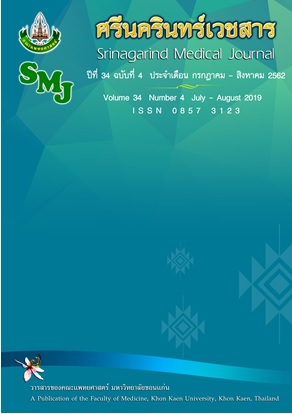Caregiver Burden and Depression among Caregivers of Individuals with Visual Impairment
Keywords:
caregiver burden; depression; visual impairmentAbstract
Background and objective: In Thailand, most individuals with visual impairment need caregivers for their living. Previous studies from many countries revealed burden and depression in caregivers of visually impaired persons. No research about this issue was reported in Thailand. This study aimed to evaluate the degree of burden and depression among caregivers of community-dwellers with visual impairment.
Methods: Participants were 114 caregivers (average age 43.5years) of individuals with visual impairment living in Kuchinarai district, Kalasin province. Their degree of burden and the risk of depression were evaluated by using Thai versions of the Zarit-CBS (full score = 88 points) and the CES-D (full score = 60 points), respectively. The Zarit-CBS score of 20 or less indicates little or no burden in caring. The CES-D score of 22 or more is considered to reflect the need for further assessment and evaluation for depression.
Results: The average scores of Zarit-CBS and CES-D were 7.3±5.5 and 4.9±3.5 points, respectively. Of 114 caregivers, five (4.4%) expressed mild to moderate burden (Zarit-CBS = 21-40 points). Only one caregiver (0.9%) might have depression (CES-D = 33 points).
Conclusions: Most of caregivers in Kuchinarai district reported low degrees of burden and depression in caring for their relatives with visual impairment.
References
2. Ballemans J, Zijlstra GAR, van Rens GHMB, Schouten JSAG, Kempen GIJM. Usefulness and acceptability of a standardised orientation and mobility training for partially-sighted older adults using an identification cane. BMC Health Serv Res 2012; 12: 1-14.
3. Zijlstra GAR, van Rens GHMB, Scherder EJA, Brouwer DM, van der Velde J, Verstraten PFJ, et al. Effects and feasibility of a standardised orientation and mobility training in using an identification cane for older adults with low vision: design of a randomized controlled trial. BMC Health Serv Res 2009; 9: 153. doi: 10.1186/1472-6963-9-153.
4. Zarit SH, Reever KE, Bach-Peterson J. Relatives of the impaired elderly: correlates of feelings of burden. Gerontologist 1980; 20: 649-55.
5. Schulz R, Mendelsohn AB, Haley WE, Mahoney D, Allen RS, Zhang S, et al. End-of-life care and the effects of bereavement on family caregivers of persons with dementia. N Engl J Med 2003; 349: 1936-42.
6. Vitaliano PP, Zhang J, Scanlan JM. Is caregiving hazardous to one’s physical health? A meta-analysis. Psychol Bull 2003; 129: 946-72.
7. Braich PS, Lal V, Hollands S, Almeida DR. Burden and depression in the caregivers of blind patients in India. Ophthalmology 2012; 119: 221-6.
8. Khan Z, Braich PS, Rahim K, Rayat JS, Xing L, Iqbal M, et al. Burden and depression among caregivers of visually impaired patients in a Canadian population. Adv Med 2016; 2016: 4683427. Epub 2016 Mar 8.
9. Braich P, Jackson M, Knohl S, Bhoiwala D, Gandham S, Almeida D. Burden and depression in caregivers of blind patients in New York state. Ophthalmic Epidemiol 2016; 23: 162-70.
10. Khare S, Rohatgi J, Bhatia MS, Dhaliwal U. Burden and depression in primary caregivers of persons with visual impairment. Indian J Opthalmol 2016; 64: 572-7.
11. ยุพาพิน ศิริโพธิ์งาม. ญาติผู้ดูแลที่บ้าน: แนวคิดและปัญหาในการวิจัย. รามาธิบดีพยาบาลสาร 2539; 2: 84-92.
12. วารุณี มีเจริญ. ญาติผู้ดูแลผู้ป่วยมะเร็ง: การปรับตัวต่อบทบาทและการส่งเสริมคุณภาพชีวิต. รามาธิบดีพยาบาลสาร 2557; 20: 10-21.
13. อรุณ จิรวัฒน์กุล. ชีวสถิติสำหรับงานวิจัยทางวิทยาศาสตร์สุขภาพ. ขอนแก่น: คลังนานาวิทยา, 2551.
14. ชนัญชิดาดุษฎี ทูลศิริ, รัชนี สรรเสริญ, วรรณรัตน์ ลาวัง. การพัฒนาแบบวัดภาระในการดูแลของผู้ดูแลผู้ป่วยเรื้อรัง. วารสารการพยาบาลและการศึกษา 2554; 4: 62-75.
15. ชนัตถา พลอยเลื่อมแสง. ความตรงเชิงโครงสร้างของแบบวัดความซึมเศร้า CES-D ในกลุ่มนิสิตนักศึกษา. วารสารเภสัชศาสตร์อีสาน 2548; 1: 25-39.
16. อุมาพร ตรังคสมบัติ, วชิระ ลาภบุญทรัพย์, ปิยลัมพร หะวานนท์. การใช้ CES-D ในการคัดกรองภาวะซึมเศร้าในวัยรุ่น. วารสารสมาคมจิตแพทย์แห่งประเทศไทย 2540; 42: 2-13.
17. Bambara JK, Owsley C, Wadley V, Martin R, Porter C, Dreer LE. Family caregiver social problem-solving abilities and adjustment to caring for a relative with vision loss. Invest Ophthalmol Vis Sci 2009; 50: 1585-92.
18. Chindaprasirt J, Limpawattana P, Pakkaratho P, Wirasorn K, Sookprasert A, Kongbunkiat K, et al. Burdens among caregivers of older adults with advanced cancer and risk factors. Asian Pac J Cancer Prev 2014; 15: 1643-8.
19. Limpawattana P, Intarasattakul N, Chindaprasirt J, Tiamkao S. Perceived burden of Thai caregivers for older adults after stroke. Clin Gerontol 2015; 38: 19-31.
20. Limpawattana P, Theeranut A, Chindaprasirt J, Sawanyawisuth K, Pimporm J. Caregivers burden of older adults with chronic illnesses in the community: a cross-sectional study. J Community Health 2013; 38: 40-5.
21. ติรยา เลิศหัตถศิลป์. ภาวะซึมเศร้าและความรู้สึกเป็นภาระในผู้ดูแลผู้ป่วยเด็กออทิสติกที่มารับการรักษาที่โรงพยาบาลธรรมศาสตร์เฉลิมพระเกียรติ. ปทุมธานี: ภาควิชาจิตเวชศาสตร์ โรงพยาบาลธรรมศาสตร์เฉลิมพระเกียรติ, 2555.
22. ภาวินี ลาโยธี, น้อมจิตต์ นวลเนตร์. การประเมินการใช้ทักษะการทำความคุ้นเคยกับสภาพแวดล้อมและการเคลื่อนไหวในชีวิตประจำวันของคนพิการทางการเห็น: กรณีศึกษาอำเภอกุฉินารายณ์ จังหวัดกาฬสินธุ์. วารสารกายภาพบำบัด 2561; 40: 41-57.
23. Foundation for Older Persons’ Development. Elderly situation in Thailand. Chiang Mai: Foundation for Older Persons’ Development; 2015.
24. Mahidol Population Gazette. Thailand population 2017. Bangkok: Mahidol Population Gazette; 2017.




